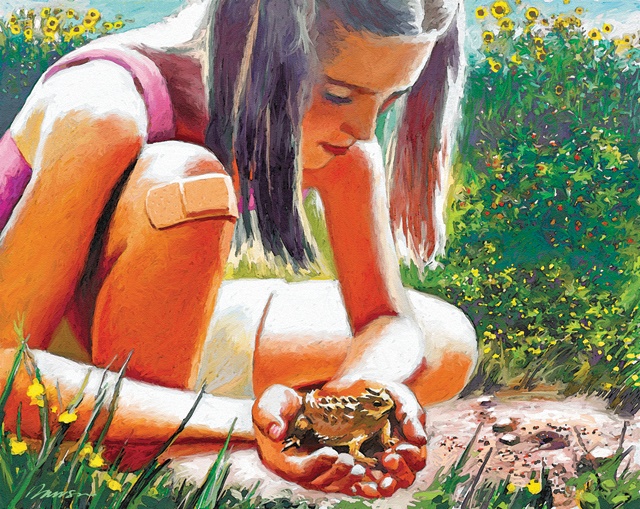My father despised the bald spots in the grass that defined our yard. Somehow, the bare patches of dirt and rocks repelled his swatches of St. Augustine grass, planted like quilt squares across our corner lot. Those 3-foot-wide crop circles didn’t complement the boxy ligustrum and pittosporum hedges that he kept so neatly trimmed along the front and sides of our brick home on Corpus Christi’s Dogwood Street decades ago.
My father did what he could to get rid of the ant beds dwelling in those dirt patches. They simply didn’t belong in his yard. Like most homeowners in our neighborhood, he regularly mowed, watered and fertilized the grass. He trimmed the shrubs into perfect boxes, edged along the street curb and treated the ant beds with pesticides.
Biodiversity and healthy ecosystems were not top of mind in suburban settings during these times. Author Douglas W. Tallamy promotes biodiversity in his book, “Bringing Nature Home” (Timber Press, 2007). But in the years of my childhood, most homeowners cared more about appearances.
As for me, then a kid of 6 growing up in northwestern Corpus Christi, I found the harvester ant beds both fascinating and dangerous. Crouched on my haunches, usually nursing at least one skinned knee from a bike crash, I’d watch the square-headed workers—dark red and nearly half an inch long—scuttle in and out of the small opening that led to their underground colony. They moved about quickly, waving their short antennae, sometimes bumping into one another but rarely stopping for long. Even from my lofty vantage, their beady black eyes and pincher-like mandibles stood out prominently.
Careless though I seemed, I did regularly monitor my white socks and beat-up sneakers. Angry ants could bite hard. I knew! But hot tears, throbbing welts and Mother’s admonishments of “Stay out of those ant beds!” couldn’t keep me away for long. Soon I’d return to follow my six-legged friends as they marched along beaten forage trails that radiated away from the beds.
I especially loved to give them seeds from the yellow-flowered clover that grew in prolific mounds around the beds. Although my father hated the weeds, he’d shown me how to unwind their prickly burs and eat the minuscule beans inside. Crouching near a red ant bed, on guard for imminent attacks, I dropped the green beans near the entrance. To my delight, most passed inspection and were carried into the hidden lair.
If only we had been more aware and known that those red ant beds sustained the chubby Texas horned lizards (scientifically called Phrynosoma cornutum) that my friend Sandy and I would chase down in grassy lots in our subdivision. Like most people, we called the reptiles “horny toads.” Another common name, horned frog, comes from the Greek words phrynos (toad), soma (body) and cornutus (horned).
“They can spit blood from their eyes,” Sandy would warn after I’d capture one with my hands. But I didn’t believe her. Of the many we caught (and let go), none ever did. (However, I did later learn that a horned lizard can indeed shoot a stream of blood from its eyelids as a defense. The species can also inflate itself, making it difficult for a predator to swallow its spiny body.)
Cupped in my hand, a horny toad would often close its white-ringed black eyes while I gently rubbed its hard snout, spiked head and broad spiny back. It usually didn’t mind my strokes on its soft white belly either. In our explorations, Sandy and I found palm-sized adults as well as babies no longer than an inch.
Horned lizards and red ants plus tadpoles, pill bugs and woolly bear caterpillars were the ready-made toys of my childhood. We also stomped down secret passages through towering colonies of common sunflowers and floated stick boats in a nearby drainage ditch. Back then, transistor AM radios, vinyl records and three TV channels, the sole extent of our modern “electronics,” couldn’t compete with the alluring outdoors.
Now, many years later, I recall those bygone playtimes with sweet nostalgia. But more often, I look back on those years with deep sadness. Yes, if only we had known how the life cycles of the harvester ants and horned lizards interconnected. How they, not the foreign ligustrums and St. Augustine, both absolutely belonged in the landscape. So did a lone chile pequin bush that poked up through one of our pittosporums and those sunflowers that for a season covered the vacant lots.
Those native species—surviving remnants of a vanishing ecosystem—provided fruit, seeds and shelter for resident birds, insects and other wildlife.
I’m not alone with my regrets. Many Texans like me remember when horned lizards—now listed as a threatened species in Texas and designated as our official state reptile—once populated much of the state. Since the early 1970s, their range has shrunk to the Panhandle, South Texas and far West Texas. Several factors are to blame, says state herpetologist Andy
Gluesenkamp with the Texas Parks and Wildlife Department. Fire ants, invasive nonnative grasses, development, road kills, domestic cats and even weather have negatively impacted horned lizards.
Yet if we’d known, what would we have done differently, I wonder. Right away, the answer’s clear: Let the bald spots stay in our yard. But certainly we had no power to stop the inevitable growth and construction that quickly wiped out the native habitat in the old neighborhood.
So it’s impossible to know the true impact of my father’s private war against the red ants. In the larger sense, few kids growing up in Texas these days can say they’ve played with wild horned lizards in their neighborhood. What a huge loss. At least I have my memories.
——————–
Sheryl Smith-Rodgers, a member of Pedernales EC, lives in Blanco.


